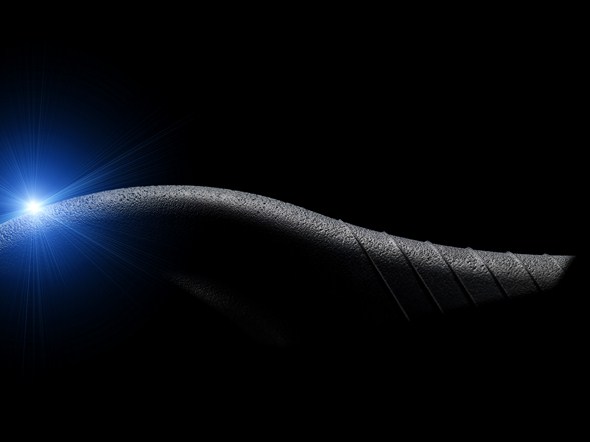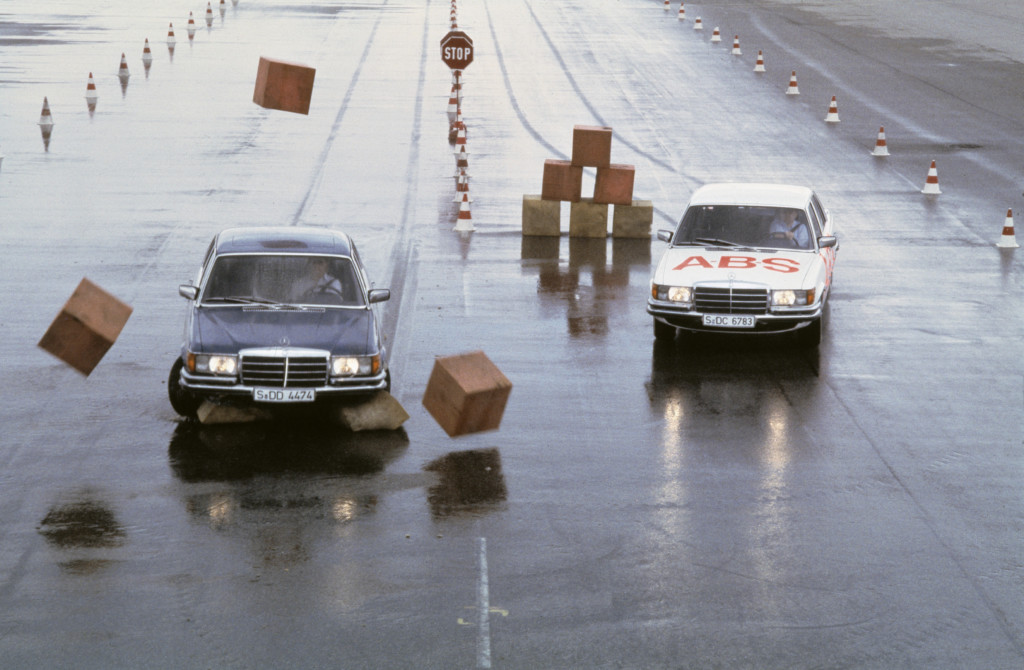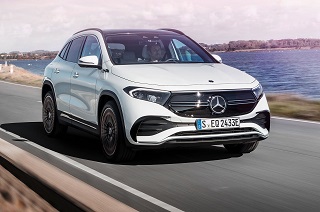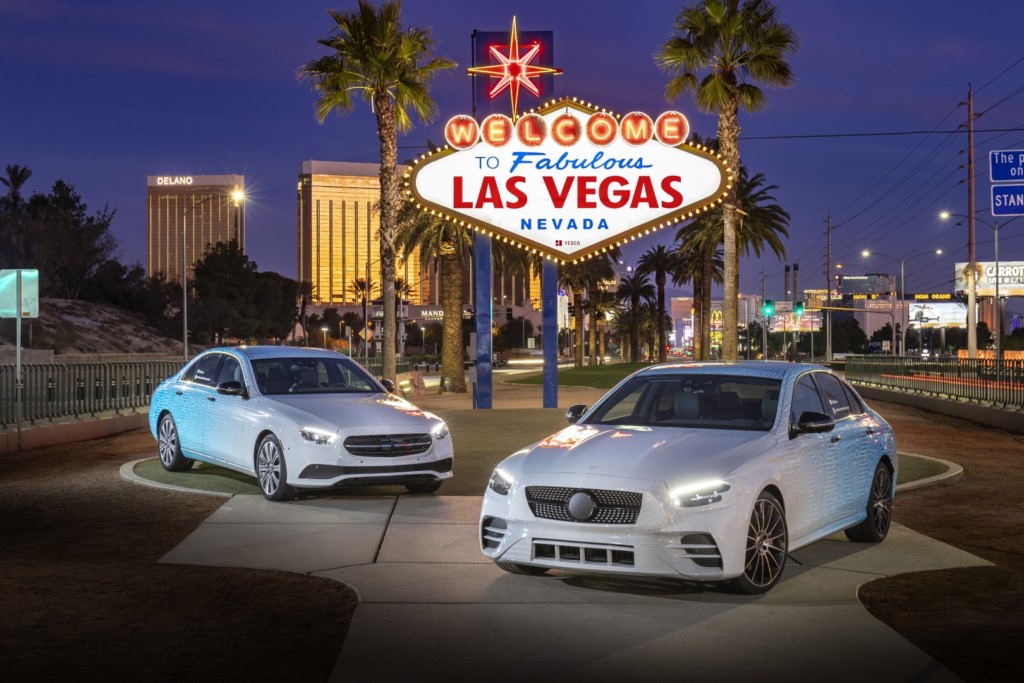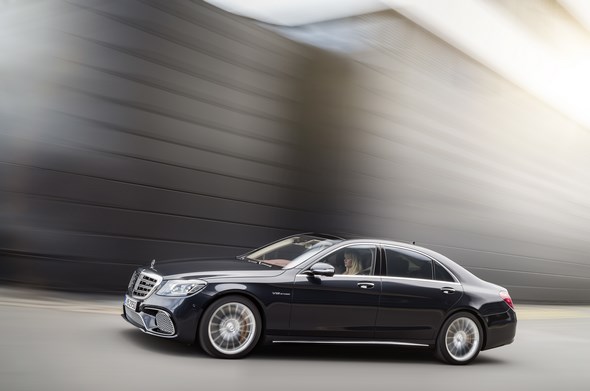TecDay – the new SL


Less weight, more vision, more sound
Stuttgart – Before the year is out, Mercedes-Benz will present a completely redeveloped SL Roadster made for the first time almost entirely from aluminium. The full aluminium bodyshell of this newly developed vehicle weighs around 110 kilograms less than a comparable bodyshell constructed with the technology used for its predecessor.
It thus reduces the overall weight of the new SL by 140 kilograms compared to its predecessor. At the same time, the new generation of this luxury sport car can be converted into an open or a closed concert hall.
This is thanks to the new bodyshell structure which makes possible the FrontBass system, unique in the world and also celebrating its debut. As a further world first, Mercedes-Benz is also presenting the highly effective MAGIC VISION CONTROL adaptive windscreen wipe/wash system.
It delivers water requirement-based and depending on the direction of wipe, directly to the wiper blade; neither a water jet nor a film of water can be seen, and yet the windscreen stays perfectly clean for the driver and
passenger.
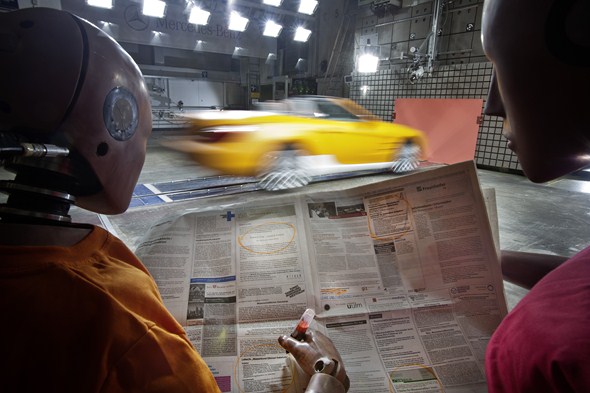
The new-generation Mercedes-Benz SL takes the meaning of the letters “SL” – sporty, lightweight – very seriously. Consistent weight reduction is one of the most outstanding design results in the new SL as was the case in its namesake, the original SL of 1954. For the first time Mercedes-Benz implements a full aluminium bodyshell in large series production.
Only very few components are made from other materials. The designers use the even lighter magnesium for the rear panel. High-strength steel tubing is integrated in the A-pillars.
The newly developed car weighs around 110 kilograms less than a comparable bodyshell constructed in analogous manner to the previous technology. “The effect is rather as if a heavyweight-class passenger had got out of the car and taken his heavy flight luggage, too” says Dr Thomas Rudlaff, responsible for the aluminium bodyshell at Mercedes-Benz.
“The result is perceptible and measurable. Less weight means more dynamism and less consumption. In other words: the motoring enjoyment increases and the environmental
burden sinks.”
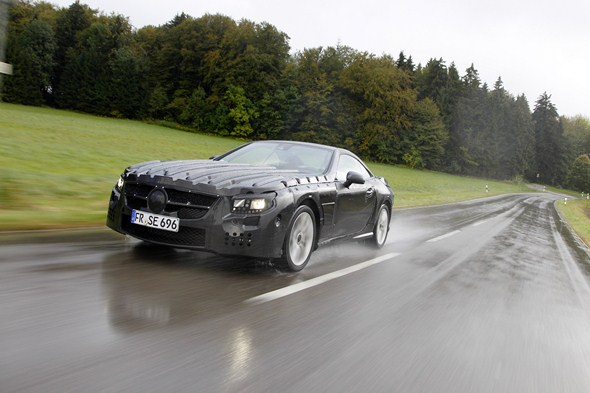
In terms of rigidity, safety and comfort, the aluminium structure proves superior to the predecessor’s steel construction. This is achieved thanks, among other things, to its intelligent lightweight construction with components optimised for their specific task.
Thus, diverse processes are used to make different kinds of aluminium depending on the use the component is to be given: the parts are made by chill casting or vacuum die casting, worked into extruded aluminium sections or into aluminium plates of different thicknesses. The result: high rigidity, high safety levels and low resonance and vibrations.
The parts are assembled using diverse load-adequate joining methods, some of which are innovative processes. Secure joints are ensured for example, by MIG welding, hemming, bonding, flow hole bolting, self-piercing rivets or friction stir welding.
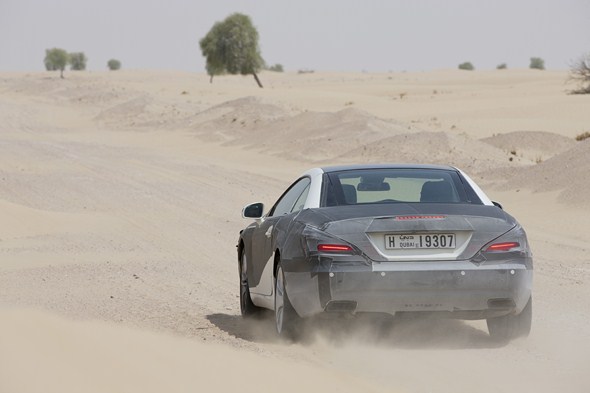
With two further innovations, the new SL remains true to its tradition as technological trend setter:
- MAGIC VISION CONTROL is a new intelligent, high-efficiency windscreen wiper/washer system. Its system of channels supplies water to the windscreen just in front of the wiper blade lip in the direction the wiper is moving. As a result, when spraying one no longer sees a water splash on the windscreen to disrupt one’s visibility, and yet the windscreen is kept perfectly clean.
- The likewise unique FrontBass system uses the free spaces in the aluminium structures in front of the footwell as resonance spaces for the bass loudspeakers. As a result the new SL features clear, crisp bass sounds that make possible a concert hall ambience even with the top down.
Both innovations are part of the extensive standard equipment of the new SL.
Aluminium bodyshell in the new Mercedes-Benz SL
Under the bottom line: 140 kilos lighter
- The bodyshell is 89 percent aluminium
- Different alloys, sophisticated sections, tailor-made cast elements
- Load-adequate joining processes
- Top-level corrosion protection
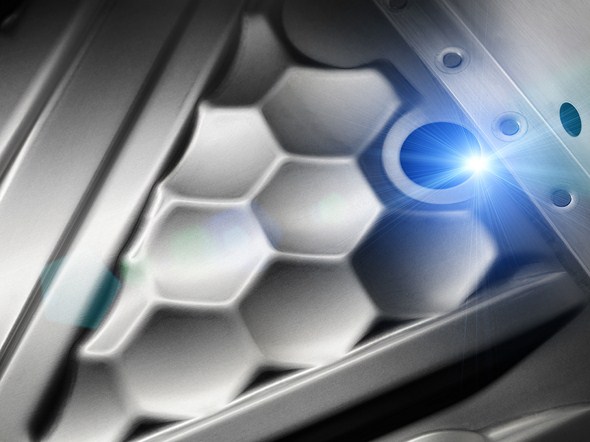
Cars are becoming increasingly safer, more comfortable, but often heavier as well. The new Mercedes-Benz SL not only stops this trend, it turns it around. In spite of increased comfort, performance and safety, it is 140 kilos lighter than its predecessor.
The greater part of the weight-reduction “diet” is hidden from the eyes of the observer of the SL. Under the aluminium outer skin there is a bodyshell made almost entirely from aluminium, only very few components being made from other materials. The even lighter magnesium is used in part for the rear panel.
The A-pillars and the roof frame are of steel sheet metal incorporating high-strength steel tubing. For these elements steel is the best solution to provide survival space for occupants in the event of the vehicle overturning. Everything else is made of aluminium.
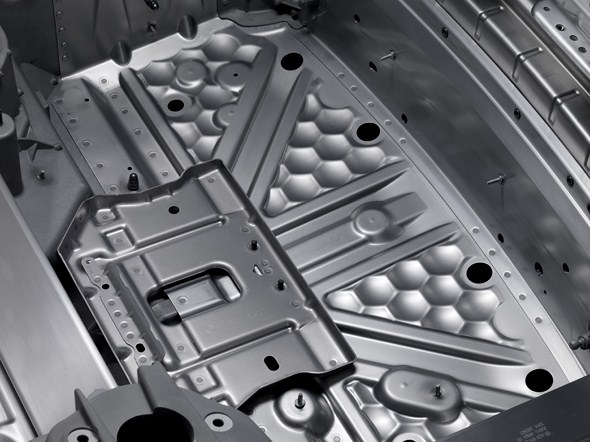
The bodyshell of the SL is the first all-aluminium bodyshell to be produced in large series at Mercedes-Benz. This entirely new development weighs 254 kilos and is thus 110 kilos lighter than a comparable steel bodyshell. Further extensive lightweight design features compensate the additional weight unavoidably caused by the increased comfort, the new assistance systems and other technical features.
Under the bottom line an enormous weight advantage remains for the new SL. The new SL 500 weighs 125 kilograms less than its predecessor, while the SL 350 weighs the above-mentioned 140 kilos less than its previous version. And its preceding model already had lightweight aluminium bonnet and doors.
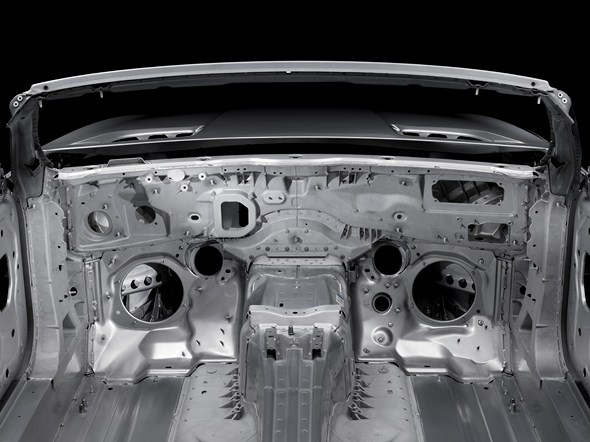
“The effect is rather as if a heavyweight-class passenger had got out of the car and taken his heavy flight luggage, too” says Dr Thomas Rudlaff, responsible for the aluminium bodyshell at Mercedes-Benz. “The result is perceptible and measurable. Less weight means more dynamism and less consumption. In other words: the motoring enjoyment increases and the environmental burden sinks.”
For the roadster the aluminium bodyshell is superior to a steel construction
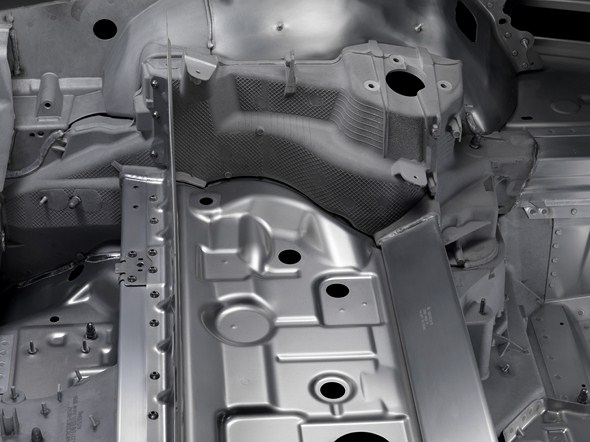
The developers at Mercedes-Benz did not rest content achieving weight benefits alone. The aluminium structure had to be superior to a steel construction in terms of rigidity and comfort as well. In order to attain this high objective, developers consistently went for intelligent lightweight construction, and explored many new paths to do this.
Every single component of the aluminium bodyshell was specifically optimised for its particular function and expected loads. Thus, diverse processes are used to make different kinds of aluminium depending on the use the component is to be given: the parts are made by chill casting or vacuum die casting, worked into extruded aluminium sections or into aluminium plates of thicknesses that vary within one and the same component; these are the so-called tailored welded blanks.
Expressed in numbers, the bodyshell weight is made up of: 44 percent cast aluminium, 17 percent aluminium sections, 28 percent aluminium sheet metal, 8 percent steel and 3 percent of other materials.
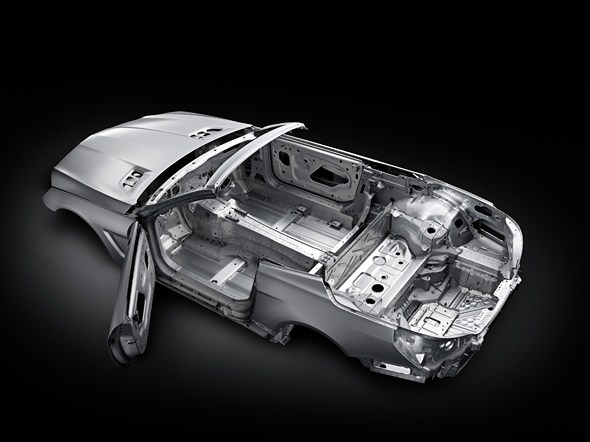
At the Bremen production facilities the parts are assembled using diverse load-adequate joining methods, some of which are innovative processes. Secure joints are ensured for example, by MIG welding, hemming, bonding, self-piercing rivets, flow hole bolting, or friction stir welding – a joining method by which a highly resistant weld seam is produced by means of friction heat; a method particularly well-suited for aluminium on account of its low melting point.
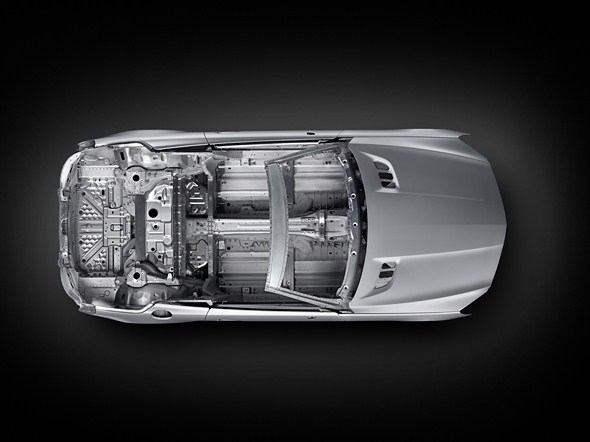
Particular highlights of the bodyshell:
- The Front Wall is at present the largest aluminium cast component made in large series for vehicle bodywork
- Many sheet metal parts are designed in such a way that for the first time they can be made from 100 percent recycled aluminium, saving 80 percent of the energy used in their production.
- The main floorpan is a 3-layer shaped panel made from thin, extrusion-moulded hollow sections, welded together by friction stir welding.
- The longitudinal members in the vehicle front end are made using high-pressure hydroforming (IHU) technology, which enables the creation of highly complex and robust components, permitting optimum use of reduced installation spaces.
- The door sills (longitudinal members) consist of 1.7-metre long, 7-chamber extrusion-moulded aluminium sections; these provide rigidity in the lateral sectors and safety in the event of a collision. Flexible chamber distribution makes possible a minimum component weight coupled with optimum characteristics.
- The tunnel is made of aluminium sheet metal with a reinforcement of varying thickness (3 different thicknesses depending on sector, a so-called tailored welded blank TWB).
- The rear sector floor is a MIG welded frame with a hollow chilled cast longitudinal member as its central element. This technique is employed in the SL for the very first time in automotive bodyshell construction.
- The rear sector floor frame structure is closed by floor sheet metal panels and the boot tub made by vacuum die-casting.
- The spare wheel recess is made from recycled sheet metal.
- The central member connects the front end with the rear sector floor. The mounting points for the drive shaft, the transmission cross beam, the transmission tunnel braces and the seat bolting points on the tunnel side are all integrated into a single element. The wall thicknesses and rib distribution are oriented bionically towards the requirements and loads.
- Many other components were optimised bionically, i.e. based on examples from nature. These structures reduce the vehicle weight compared to a classic design even further.
The sum total of all the design measures leads to a lightweight, torsionally and flexurally rigid bodyshell with an optimum rigidity/weight ratio. It was possible to increase the bodywork’s torsional rigidity by more than
20 percent over the already highly rigid preceding series.

This is confirmed by measurements of the new SL’s torsional strength – at 19400 Nm per degree the roadster achieves an absolute top value (its predecessor already reached the astounding figure of 16400 Nm per degree).
Meets the highest safety standards
At the same time the high-strength structural elements of the aluminium bodyshell make the new SL even safer than the preceding model in the event of a collision. Extrusion-moulded sections, connecting cast nodes and double-thickness plate floor form a passenger compartment that is just as lightweight as it is sturdy.
Two aluminium sections in each door together with the side sills (very rigid thanks to their internal chamber structure) and crash-resistant seats provide the greatest possible survival space in the event of a side-on collision.
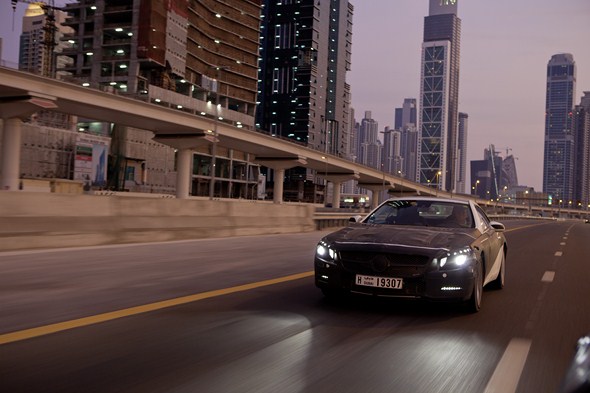
A front end deformation zone acting on several levels and in which the aluminium front axle integral carrier is integrated as an additional third longitudinal member, distributes collision forces to a large area, conducting them past the passenger compartment.
And in the rear, too, there is sufficient energy-absorbing deformation potential. A structural cage made from chilled cast longitudinal members, transversal sections and a cast magnesium tank separation bulkhead also contribute to this. This is also where the fuel tank is nested in a crash-protected manner above the rear axle. This way all the statutory safety requirements are met as well as the even stricter ones from Mercedes-Benz.
Best marks for NVH comfort
Thanks to its innovative aluminium bodyshell concept, the new SL is also unique among the roadsters in terms of NVH comfort (noise, vibration, harshness). One contributing factor towards its optimum vibration-and top-level roll characteristics is, among other things, the extremely rigid connection between front end and vehicle rear section.
This makes for relaxed travel, even on long journeys, while delivering thrilling driving dynamism at the same time.
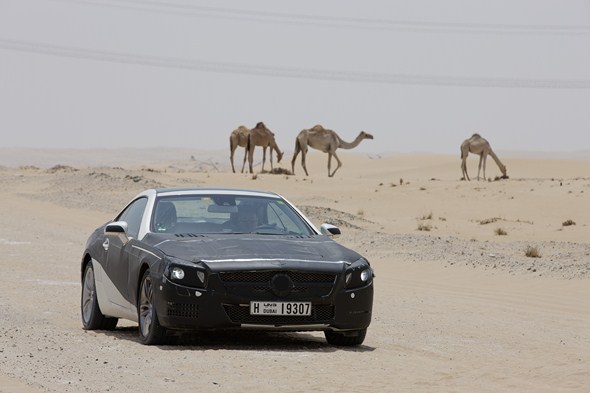
Although aluminium features a higher sound emission and radiation level than steel, the new SL is the quietest vehicle in its class. Mercedes-Benz compensates for the acoustic disadvantages of aluminium by means of a
consistent sound insulation concept with targeted adaptation of the sound damping materials to each problem zone, and through the use of innovative sound insulation materials:
- A special firewall damping with variable mass distribution and a significant heavy layer proportion attenuates engine noise.
- In conjunction with the plate floor, single-piece, foam-backed carpeting with virtually no seams reduces the roll noise of the vehicle in the interior.
- A spray-on lining attenuates the structure-borne sound in the vehicle interior and exterior.
- Textile wheelhouse linings, acoustically absorbing shield plates and bodyshell foam elements for critical sectors also contribute towards a smooth ride.
- Damping in the rear wall transversal cross member and boot lateral elements as well as in the forced ventilation openings prevent disruptive tyre and wind noises from making themselves unpleasantly noticeable in the vehicle interior.
A further contribution to the good interior acoustics is the laminated glass windscreen with acoustic film. The transparent, highly resilient film absorbs the vibrations of the windscreen and reduces the perceptible sound level in many frequency ranges.
The doors and the bonnet, too, are lightweight
The intelligent material mix is completed by the boot lid, of SMC-hybrid design (SMC = sheet moulding compound). It consists of a single-shell synthetic material panel mounted on a steel reinforcement. Both materials have virtually identical thermal expansion coefficients and complement each other very well.
The interior steel construction permits maximum rigidity with minimum use of space, while the plastic panelling allows the full integration of the aerials for navigation, digital radio and mobile telephony out of sight in the rear area so that the SL, unlike many other vehicles, does not need to carry an aerial stump on its aerodynamically refined body.
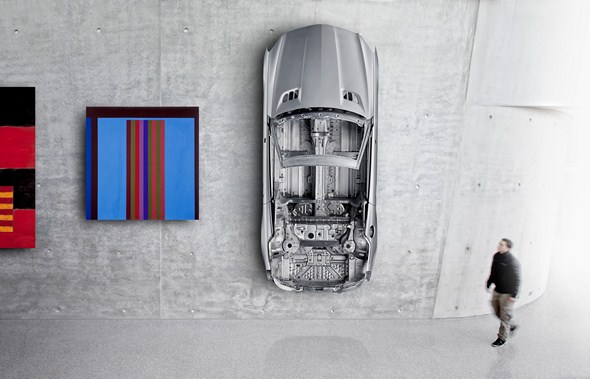
The bonnet of the SL is made from aluminium, as that of its predecessor. It was optimised in terms of form and materials, contributing towards outstanding pedestrian protection.
The doors, too, are of a lightweight design and made from aluminium. They are fashioned from a combination of sheet metal, extruded sections and cast metal parts, joined by diverse methods: riveting, bonding and hemming.
Their aluminium and steel hinges are friction-based and can be opened infinitely adjustable to any desired angle, so that when getting into or out of the car they can remain securely open at any angle permitted by the space available at the side. This is particularly desirable in cramped parking conditions such as in a parking garage or on a parking lot.
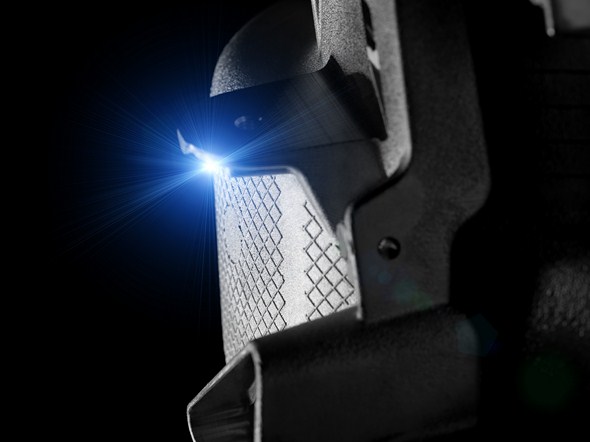
Sophisticated corrosion protection concept
“The corrosion prevention measures used on the new SL are the best you can find on the market” says Dr Paul Dick, responsible for corrosion prevention at Mercedes.
The aluminium bodyshell of the new SL offers no point of attack for corrosion. A sophisticated surface protection concept ensures the preservation of the brilliant look both of the outside skin and of the underside of the sheet metal panels, thus protecting at the same time the renowned reliability and value stability of Mercedes-Benz vehicles.
The protection concept was developed and tested on the basis of the environmental burden in different climate zones of the world and the specific loads the vehicle is subjected to. The foundation for maximum corrosion resistance is formed by corrosion-resistant aluminium alloys and design features, while the few steel vehicle components are all fully galvanised.
High-quality zinc-nickel coatings or special electrochemical insulation measures prevent contact corrosion with aluminium. All the seams are meticulously sealed, the surfaces protected through cathodic dip priming and multiple coats of paint. Sectors particularly exposed to corrosion are additionally protected with wax, to ensure that the pristine aspect of the new car is preserved for a long time.

MAGIC VISION CONTROL adaptive windscreen washing system
Conjuring trick for outstanding visibility
- World premiere – wipe and wash systems folded into one
- A duct system takes the water directly to the wiper blade
- Three partly autonomous wash programmes
- Fully heated system against snow and ice
An astonishing experience: the wiper blade glides over the badly soiled windscreen of the future new SL, without a sign of a cleaning water jet, the occupants cannot see anything yet the windscreen is still cleaned!
The new SL is the first vehicle to be equipped with the high-efficiency adaptive MAGIC VISION CONTROL wiper/washer system developed by Mercedes-Benz. It cleans the windscreen without the familiar splash of water that usually briefly disrupts the driver’s field of view – something that is especially unpleasant at night or when the sun is low in the sky.
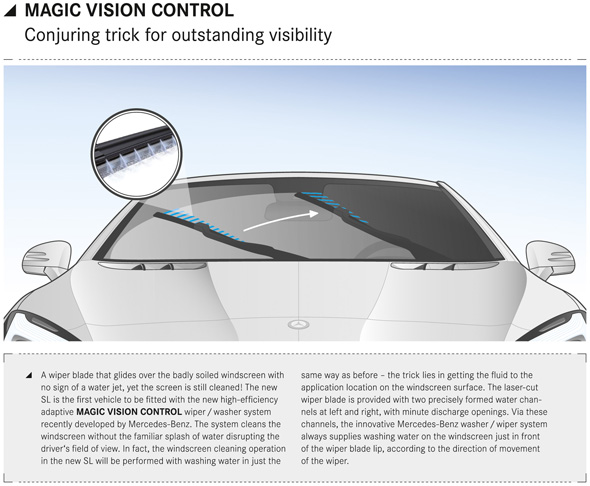
In fact, the windscreen cleaning operation in the new SL will be performed with washing water in the conventional manner. The innovation lies in the way the fluid is conducted to the windscreen in order to clean it. This is done by means of a sophisticated system of ducts that go to the wiper blade, which is flanked by two precisely formed water channels at left and right, with minute laser-cut discharge openings. Via these channels, the innovative Mercedes-Benz washer/wiper system always supplies washing water to the windscreen efficiently and discreetly precisely where it is needed: just in front of the wiper blade lip, according to the direction of movement of the wiper. The discharge openings are distributed along the entire length of the wiper blade, being more closely spaced towards the outside of the blade, where it sweeps a greater area, than closer in, where the area swept is smaller.
Programmes for summer, winter and cabriolet operation
Mercedes-Benz controls the MAGIC VISION CONTROL system, the first integrated windscreen wipe/wash system in the world, intelligently via three partly autonomous wash programmes – for summer, for winter and for
cabriolet driving. In summer, small quantities of water are sufficient to remove a light powdering of dust.
In winter the dirt mixed with de-icing salt requires a greater amount of water. The MAGIC VISION CONTROL system not only works in accordance with the season, it also automatically adapts the wiper water quantity to the surrounding conditions, such as e.g. the ambient temperature, road speed, and the current driving situation.
If, for example, the windscreen should happen to be heavily soiled in summer, the system will automatically deliver a greater amount of water to the windscreen.
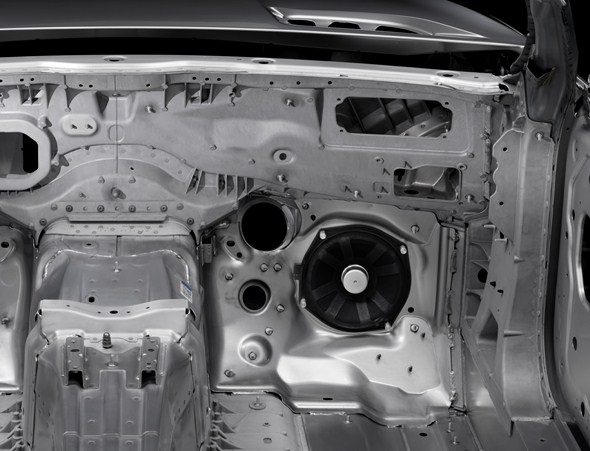
A particularly interesting feature of the SL Roadster in the Cabriolet function: when the hard top is down, the electronic control system reduces the amount of water, apart from which it demands the required water mainly on the downward stroke of the wiper arm.
This way the windscreen can be conveniently cleaned at all speeds and with open roof without any of the water spraying into the vehicle interior. Another pleasant side effect: since the wipe water is directed specifically and well-metered to the area to be cleaned, one doesn’t douse anyone else in the surroundings with water, either. At the end of the day, an equally good or even better cleaning effect is attained with only around half the otherwise needed amount of wipe water.
Because of this, a smaller water reservoir suffices perfectly so that it has been possible to reduce its volume by 1.7 litres compared with the preceding model. This in turn means less weight and consequently greater efficiency.
A heating system makes winter-proof
The new SL’s MAGIC VISION CONTROL wiper blades can be optionally fully heated. With this, Mercedes-Benz offers for the first time in the world and as the only automaker, a fully heated wiper/washer system. It consists of a washer fluid container heated through coolant residual heat, electric heating for the entire hose system and as a newly-developed highlight, a fully heated wiper blade. This effectively prevents the formation of snow on the wiper blades, so typical in winter.
To do this each of the spring rails of the blade is equipped with a heater foil with an output of 35 Watts per blade. It heats the spoiler and the wipe lip. Snow and ice cannot freeze onto the blade; it remains supple in winter, too, and cleans just as well but with reduced wiping noise.
The heating is also controlled requirement-oriented according to duration of operation and outside temperature. It is only below a temperature of minus 20 degrees Centigrade that the system makes use of the entire system’s maximum output, 270 Watts.
Between 5 degrees above and 20 degrees below zero the heating operates in an energy-saving mode and only requires the output needed to thaw out the wiper/washer system and keep it snow and ice free.
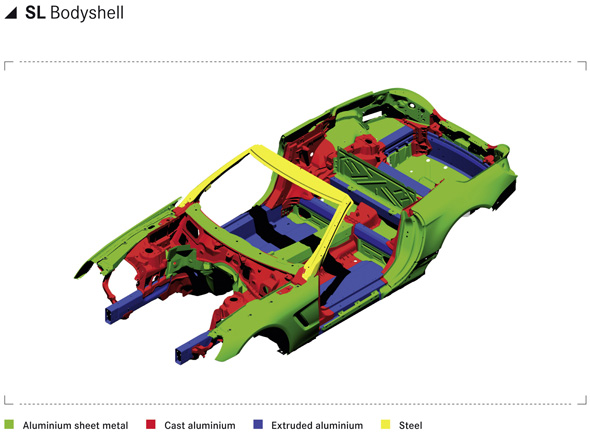
FrontBass: open-air enjoyment with listening pleasure
The fully integrated sound of tomorrow
- Crystal-clear sound with high dynamism, even with the top down
- The bass system uses support structure of vehicle as resonance spaces
- Precisely defined sound characteristics for a concert hall ambience
As a rule, those gifted with a sensitive sense of hearing cannot expect much listening enjoyment in a roadster. Even good auto radios and CD players are disappointing under these arduous acoustic conditions. Instead, in open-top cars, the music flies away with the wind; it frays and breaks up in all directions without its acoustic base – passengers generally have to be satisfied with a woolly “sound carpet”, or close the roof.
Open-air pleasure and musical enjoyment could hardly be expected in a roadster. A great part of the blame for this lies with the location of the bass loudspeakers in the doors or under a seat. Mercedes-Benz now presents a solution to this conflict: the unique FrontBass system, which at last creates the conditions for a concert hall ambience in a roadster too. In the future new SL, the FrontBass system celebrates its world premiere.
Crisp bass sound from the footwell
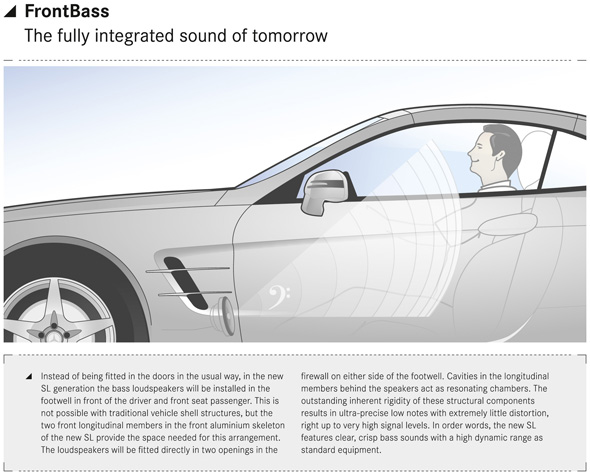
The principle sounds simple: Instead of being placed in the doors in the usual way, in the new SL generation the bass loudspeakers are installed in the footwell in front of the driver and front seat passenger. This is not possible with traditional vehicle shell structures, but the two front longitudinal members in the front aluminium skeleton of the new SL provide the space needed for this arrangement.
The loudspeakers are fitted directly in two openings in the firewall on either side of the footwell. Cavities in the longitudinal members behind the speakers act as resonating chambers.
The outstanding inherent rigidity of these structural components results in ultra-precise low notes with extremely little distortion, right up to very high signal levels. In order words, the new SL features clear, crisp bass sounds with a high dynamic range as part of its standard equipment.
The position of these two independent closed bass boxes in the footwell permits the creation of ideal acoustic conditions. Because the firewall, the vehicle floor and the underside of the dashboard form a sort of funnel that
focuses and concentrates the sound – a better sound performance is the result.
The acoustic effectiveness improves significantly. The formula: low energy, lots of sound volume, saves energy of top of it all. This way, the FrontBass system also contributes towards a CO2 reduction.
Precise, brilliant sound
With the new FrontBass system, Mercedes-Benz not only revolutionises in-car bass sound reproduction – and in particular aboard an open-top roadster – it also creates the conditions for exceptional listening enjoyment. Since the bass loudspeakers now do not need to be installed in the doors, the disruptive acoustic vibrations typical of this configuration no longer occur.
In addition to this, the sound experts have placed the mid-range and high-tone loudspeakers in the doors, the dashboard and in the vehicle rear optimally close to the waistline and thus almost at the same height as the SL occupants’ ears. This way they display a precise, brilliant sound quality. The experts speak of an exact stage reproduction with precise instrument representation and an equally precise spatial graduation.
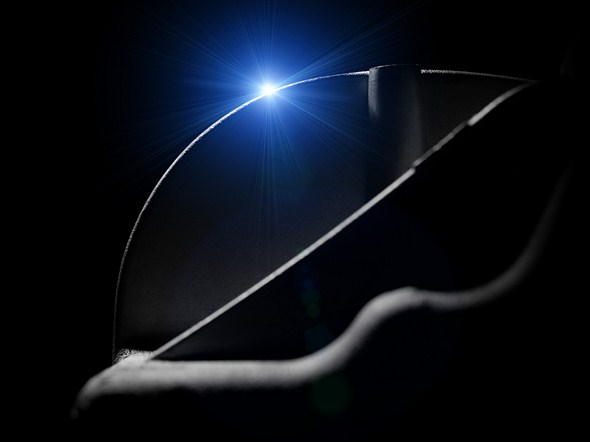
Even the standard entry level FrontBass system creates a pronounced encircling sound feeling and an emotive sound experience, aided by the perceptible pressure wave from the footwell, independently of whether the vehicle roof is open or closed.
Norbert Niemczyk, responsible for the new FrontBass system at Mercedes-Benz: “Our objective was not mere sound volume – although in this respect, too, the system performs amazingly – but a clear sound instead, one that never becomes “mushy”. We have achieved this. All those who experienced the sound with the FrontBass system for the first time got out of the car with a big smile on their face – in-house we call that the FrontBass smile.”
Friendly to the surroundings: focused sound
Acoustic enjoyment of the highest level is part of the programme in the new SL both with closed and with open top. As the FrontBass system focuses the sound, the powerful sound is concentrated on the vehicle occupants –
the surroundings are significantly less disturbed than is the case with conventional sound systems.
Apart from this, the amplifier automatically controls the loudspeakers in a different manner depending on whether the passenger compartment is closed or open, according to the acoustic conditions, in order to create the best possible sound.
FrontBass is always on board
The FrontBass concept is the standard basis in every version of the new Mercedes-Benz SL. In the entry-level variant it is coupled with an amplifier that is integrated in the COMAND head unit with an output of 4×25 Watts, two FrontBass loudspeakers with a diameter of 217 mm, two two-way systems for high and mid-range tones in the doors and two more mid-range speakers in the rear.
The optionally available Harman Kardon® Logic 7® surround sound system in conjunction with the FrontBass system are a further enhancement and a musical delicacy of concert hall quality. The heart of the matter is a Class D amplifier with a total output of 600 Watts and digital signal processor (DSP) for ten audio channels. The two FrontBass loudspeakers and six two-way systems provide an even more precise and better defined sound reproduction quality.
And finally, the absolute summit is the also optionally available Bang&Olufsen sound system. Its two Class-D ICE power amplifiers with a combined output of 940 Watts deliver exclusive audiophile high-end sound to the vehicle via their integrated digital signal processor and its 12 high-end loudspeakers.
Bodyshell tuned to FrontBass
In order to realize the FrontBass concept, the sound specialists worked in close cooperation with the bodyshell designers right from the very first planning stage. A small welcome side effect: since the FrontBass concept made the loudspeakers in the doors superfluous, the designers were able to use the space made free in the doors for additional stowage compartments.
